Fin Garden is one of the most famous and significant tourist attractions in Kashan. Not only it is registered as a national monument, but it’s also among the 9 Persian Gardens listed as a UNESCO World Heritage Site. The garden is so beautiful that it’s often referred to as a perfect example of Iranian garden design. Thanks to its numerous fountains, pleasant water sounds, and towering trees, Fin Garden is an ideal place for a stroll; especially since there is tea house that also offers a chance to fully enjoy these precious moments.
In addition to this, the garden houses several historical buildings like the Karimkhani Nook, the boiling pool, the Qajar Shotor Galu (camel’s neck), the water distribution area, and the Kashan National Museum, all of which are worth visiting. Perhaps one of the main reasons for Fin Garden’s fame is the murder of Amir Kabir, the renowned prime minister of Iran, which is considered one of the most important historical events that took place in the garden. This article will further discuss the Fin Garden in Kashan and its astonishing engineering and interesting water supply system.
Introduction to Fin Garden in Kashan
Fin Garden, a popular sightseeing spot in Kashan, was listed as a national monument in 1314 and as a World Heritage Site in 1390. Covering an area of 33,799 square meters, it’s incredibly majestic and royal, thanks to its walls, watchtowers, and cylindrical towers. Hence, it’s also known as the “King’s Garden.”
An interesting aspect of this garden, according to some people’s belief, is that throwing a coin into the main pond will fulfill a wish. While this act is seen as a fun activity, its origin can be traced back to Zoroastrianism, where water symbolizes purity, and followers would donate a part of their wealth to the water deity to bring blessings to their homes.
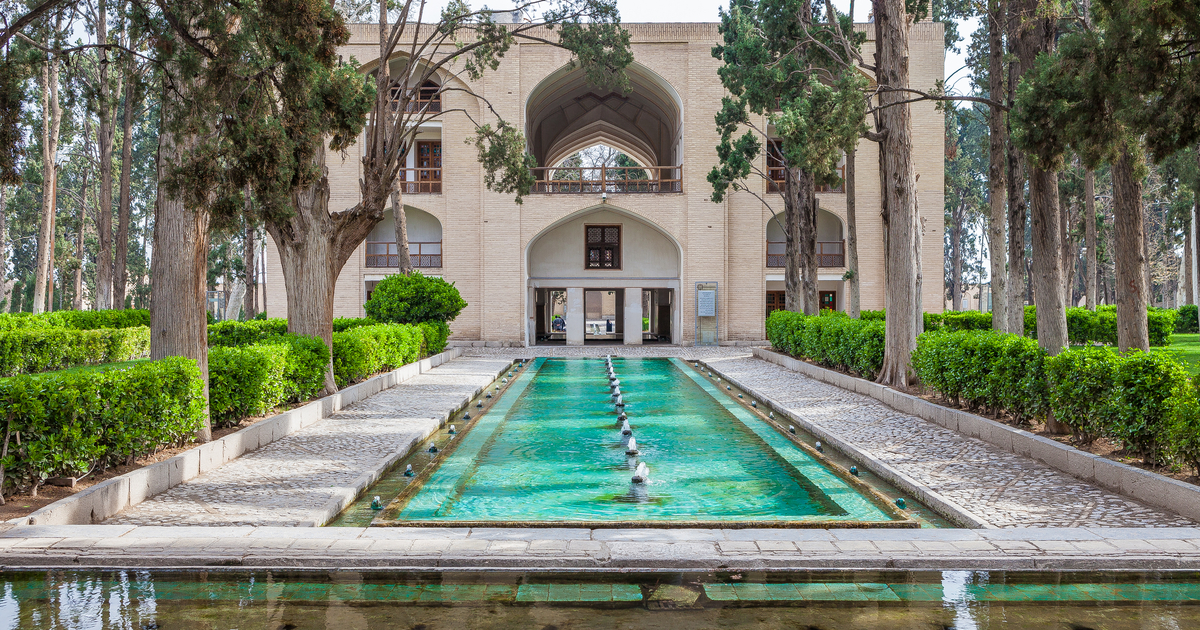
Where is Fin Garden Kashan?
To visit Fin Garden, you need to head to the historic city of Kashan in Isfahan Province and follow the route to Amir Kabir Street until you reach the expansive and lush Fin Garden.
History of Fin Garden Kashan
The Fin area has been a place of interest for kings and rulers for centuries, thanks to a spring located there. The exact age of Fin Garden is unclear, leading some to attribute its construction to the era of Ardashir Babakan. However, the first historical reference to Fin Garden dates back to the time of Ya’qub Layth Saffari, who mentioned a spring and garden in the central deserts of Iran.
According to historical sources, some experts believe that the garden was formed during the Al-Buwayh era, while others associate it with the Ilkhanate period, especially since Yaqut Hamawi, a 7th-century lunar Hijri historian, mentioned the people of Kashan visiting the gardens of Fin.
In 1544 AD, during the late reign of Shah Tahmasp, Fin Garden was severely damaged by a massive earthquake. What is today known as the Old Garden are the remains of that earthquake, located a few hundred meters from Fin Garden.
During Shah Abbas I’s reign, efforts were made to develop Kashan, and it was then that the present-day Fin Garden, known as “New Fin Garden,” was built. Round and tall towers were constructed for the new garden, and a wide street and plaza were established between the old and new gardens, intended for polo and various competitions and games.
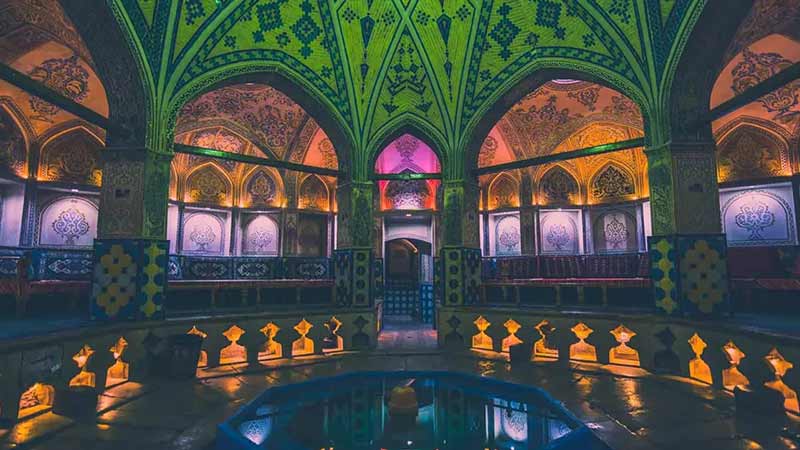
Shah Abbas also ordered the construction of a stone and sarooj dam about one kilometer south of the garden to prevent flooding, a structure that still exists today. Additionally, Hasan Naraghi’s book on the historical monuments of the Kashan and Natanz districts mentions the construction of a palace and tall towers around Fin Garden.
The construction and expansion of the new garden continued after Shah Abbas, during the reigns of Shah Safi and Shah Abbas II. During Shah Safi’s time, the upper floor of the Safavid Shotor Galu was built using wood and iron to enjoy the surrounding views from the highest point.
Besides the entrance gate, structures like one of the garden’s baths and the Safavid pavilion were also built during this period. Shah Suleiman Safavi was not left behind and ordered the construction of a platform around the Fin spring, possibly leading to its fame as the “Suleimaniyah Spring.” The stone pavements of Fin Garden, with their sunburst designs, date back to the Safavid era.
Zand Era
Fin Garden Kashan lost its prominence from the late Safavid to the Zand era, until Karim Khan Zand ordered the restoration and renovation of the garden and its structures. Along with these restorations, a new building called “Karimkhani Nook” was added to the garden.
Qajar Era
Most of the current structures in the garden date back to the era of Fath Ali Shah Qajar, who had a great fondness for Fin Garden and its spring. He ordered the ruler of Kashan to refurbish the garden and give it a royal appearance. Therefore, in addition to a small bath near the Safavid bath, a camel’s neck mansion was built next to Karimkhani Nook. The camel’s neck of Fath Ali Shah can be found in the southeastern part of Fin Garden.
Other changes during this period include adding paintings depicting hunting and Fath Ali Shah’s official court to the Safavid camel’s neck building, constructing a royal bath, and building the Nizam al-Dowleh’s retreat.
In 1256 lunar Hijri, Mohammad Shah ordered the garden to be restored. Additionally, the Shah Neshin mansion and the boiling pool were built during his reign.
The construction of the windcatcher mansion (currently a library), the restoration of the garden’s large and small baths, and the addition of seven-color and turquoise tiles are other achievements of the Qajar era.
Pahlavi Era
During the Pahlavi era, in 1314, Fin Garden was nationally registered, attracting even more attention to this remarkable site. Around the same time, the garden’s central pool was also restored. In 1336, the foundation stone of the Kashan National Museum was laid on the ruins of the Nizam al-Dowleh’s retreat. In addition to the building near the baths and the library, many parts of Fin Garden, such as the pavilions, were restored in 1357.
Post-Islamic Revolution
Fin Garden did not receive much attention after the Islamic Revolution of Iran. However, in 1387, various actions were taken, such as organizing the garden’s flooring and internal canals, restoring the entrance mansion, roofing the Safavid pavilion, and installing CCTV cameras.
After the world registration file for Fin Garden was formed in 1389, changes were made to the garden’s walkways and stone pavements following UNESCO’s request.
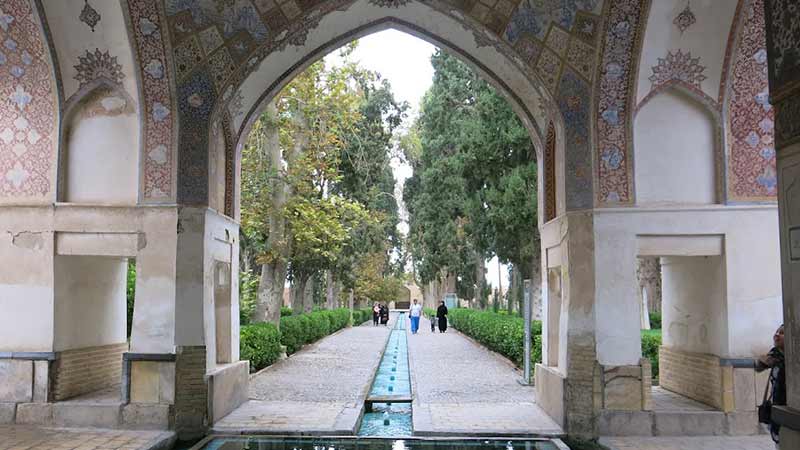
Historical Events of Fin Garden
Fin Garden Kashan has witnessed important events and incidents throughout history, some of which we briefly mention here.
Celebration of Shah Ismail Safavi
At the beginning of his reign, Shah Ismail Safavi went to Kashan and held a public celebration in Fin Garden. The people decorated the city in his honor. During his two visits to Fin Garden, Shah Ismail brought joy to the people by holding festivities and dances in the garden.
Murder of Khizr Nahavandi, Governor of Kashan
Khizr Nahavandi, the long-time governor of Kashan with significant power, was attacked by a knife-wielding assailant in Fin Garden around 986 lunar Hijri and was killed. It was later said that this was a political assassination ordered by Shah Abbas.
Death of Shah Safi
Shah Safi frequently visited Fin Garden in Kashan. However, during his last trip, while staying at the Dowlathouse mansion, he reportedly died from excessive alcohol consumption. Following this event, his 10-year-old son was crowned in the garden.
Murder of Amir Kabir
Mohammad Taghi Farahani, known as Amir Kabir and the prime minister of Naser al-Din Shah, significantly contributed to Iran’s prosperity with actions like establishing Dar al-Funun (First western-style higher education institute in Iran), organizing the army, dividing the water of Karaj, and setting salaries for courtiers. Although he was a popular figure with the Shah, the existence of enemies such as the Shah’s mother and Haj Ali Khan Maraghei led to his dismissal and exile to Kashan. Forty days after this incident, Naser al-Din Shah regretted his decision and sent a robe of honor to Amir Kabir. However, knowing this, Amir Kabir’s enemies took advantage of the Shah’s drunkenness to obtain a royal decree for his assassination.
The assassins reached Kashan and Fin Garden while Amir Kabir was in the bath. They entered through an alley, conveyed the Shah’s order to Amir Kabir, and he requested to see his wife and children for the last time, write a few lines of a will, and pray two rak’ahs. These requests were denied, and he was only allowed to choose his method of execution. Amir Kabir asked the bathhouse attendant to cut his wrist.
To hasten their task, the assassins didn’t wait for Amir’s natural death and strangled him with a cloth. This grim incident occurred on January 10, 1854, leading to a seven-day period of public mourning in the city of Kashan. His body was buried in the Imamzadeh Habib ibn Musa in Kashan, and two years later, Amir’s wife transferred it to Karbala to be laid to rest in the shrine of Imam Hussain.
Refuge of Naib Hossein Kashi
Naib Hossein Kashi and his companions were rebels during the era of Mohammad Ali Shah. They went to Fin Garden and stayed there for about 14 years, leading to the partial destruction of the garden. Eventually, the central government captured them and in 1919, they were sentenced to death.
Who built the Fin Garden?
During the reign of Shah Abbas I, the development and prosperity of Kashan were prioritized, leading to the foundation of the modern Fin Garden. The cultural heritage identifies Ghiyath al-Din Jamshid Kashani as the designer of Fin Garden; the famous Safavid era mathematician who understood the principle of pressure difference 200 years before Pascal, making the most of the natural slope in Fin Garden. However, some experts believe Sheikh Bahai was the actual designer.
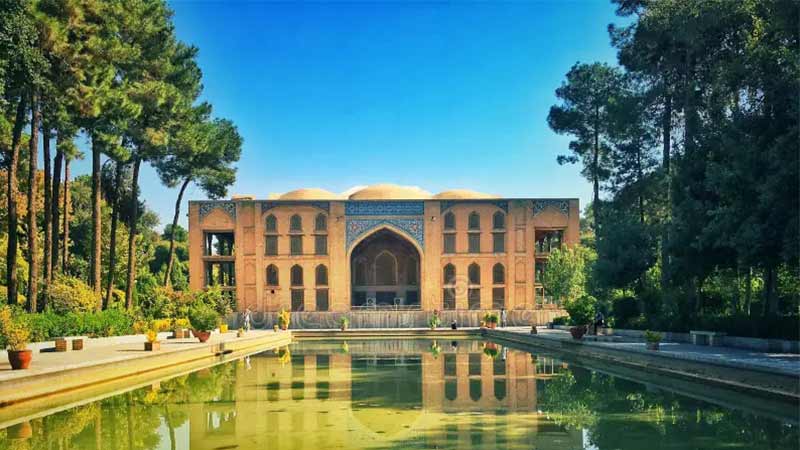
Architecture of Fin Garden in Kashan
In the architecture of Fin Garden in Kashan, in addition to dynamic elements like water and trees, the static architectural elements, namely the buildings, create a dreamlike space. Although maintaining symmetry was initially important in the garden’s design, over time this aspect became less prominent, as seen in the garden’s axes and structures added after the Safavid period.
Pathways of the Garden
The garden’s longitudinal axis is situated right in the middle, running northeast-southwest, leading to the main entrance at the northern facade. The east-west passageway, one of the garden’s main paths, is flanked by the National Museum of Kashan and the Amir Kabir Library. A north-south passageway also starts from the main building’s entrance.
There’s also a secondary pathway stretching from south to north, starting from the camel-neck building in the southern side and ending at one of the garden’s secondary entrances in the north.
Trees
Trees are also fundamental elements of Fin Garden, enhancing its beauty. In addition to 579 cypress trees, 11 plane trees stand out, several centuries old. The oldest trees, known as the Lili and Majnun cypresses, about 500 years old, are located near the Qajar pavilion. This highlights the significant role of the evergreen cypress tree in garden design. Certainly, planting a few plane trees among the cypresses was meant to increase the garden’s visual appeal. Other trees like mulberry, quince, fig, etc., are also visible in the garden.
Despite the importance of these trees, various factors in recent years such as unprofessional intervention, electric cables, improper watering, pipe installations, severe frostbite, management issues, etc., have caused drying and diseases in the trees.
Boiling Pool in Fin Garden
The boiling pool is a fascinating part of Fin Garden, attracting many tourists. The pool’s floor is fully tiled, bearing patterns similar to Kashan carpets. These tiles were stolen in the early Reza Shah period by looters led by Naib Hossein Kashi and taken to a private garden; however, lacking the skill to install the complex tile system, they were of no use. Apart from a few that were destroyed, some of these tiles were sold to the Louvre Museum in Paris.
The boiling pool has 160 holes, each symbolizing carpet flowers. Interestingly, when water jetted out of the first hole, the second hole acted as a suction for the water. Thus, half of the holes were for jetting water and the other half for suction, ensuring no water overflowed from the pool. These features make it a masterpiece of water engineering, seemingly designed by Ghiyath al-Din Jamshid Kashani, and its dimensions follow the golden ratio.
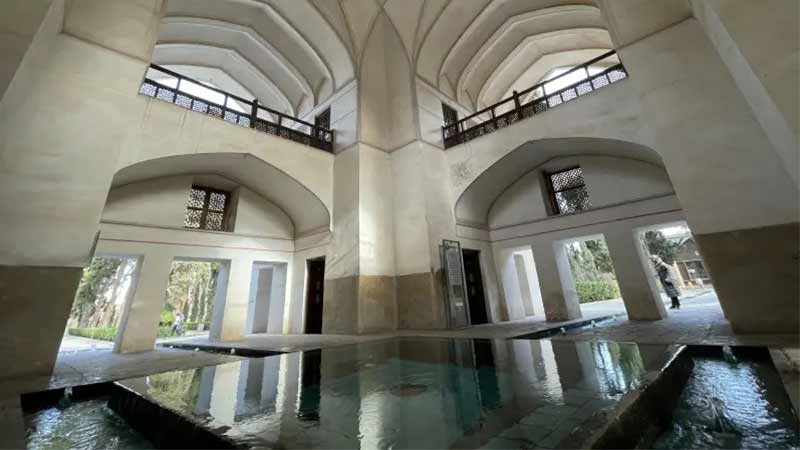
Twelve-Fountain Pool
The Twelve-Fountain Pool was built during the reign of Mohammad Shah Qajar and is like a water channel filled with fountains, another wonder of Fin Garden. Located after the boiling pool, when water enters this pool, it flows through the terracotta pipes to the Twelve-Fountain Pool, activating its fountains. Interestingly, the philosophy behind the use of pool houses and water features in Iranian gardens was to create a sense of calmness through the sight and sound of water, as well as to cool the environment.
Buildings in Fin Garden
Safavid Pavilion
The Safavid Pavilion (Sofeh-e Abbasi) was built in two stories during the reign of Shah Abbas I as a place for ceremonies, celebrations, and recreation. The Kolah Farangi building was added during Shah Safi’s era, though none of it remains today. The pavilion, essentially a small palace, was built at the intersection of the garden’s main axes, in the center of the Iranian garden.
The Safavid Pavilion is quadrangular, with an exceptionally beautiful pool in its center. Faint paintings by Reza Mousavi Kashani at the entrance of the building are fascinating to all viewers. These paintings were damaged during the Afghan invasion and an earthquake and were plastered over during the Qajar era. However, parts of them have been uncovered from under the plaster.
Another characteristic of this building is the water flow on both sides, with the main part including a large pool downstream of the pavilion and the Twelve-Fountain Pool upstream.
Visiting this pavilion, you’ll come across the coin pool, also known as “Shotor Galoo.” There’s a hole in the middle of the pool, two meters deep, with a terracotta pipe resembling a camel’s neck or the English “S”; this pipe shape causes water to forcefully jet out from the pool’s center, leading visitors to believe there’s a spring in the middle of the pool. Tourists throw coins into the pool, believing that if a coin falls into the hole, their wish will be granted.
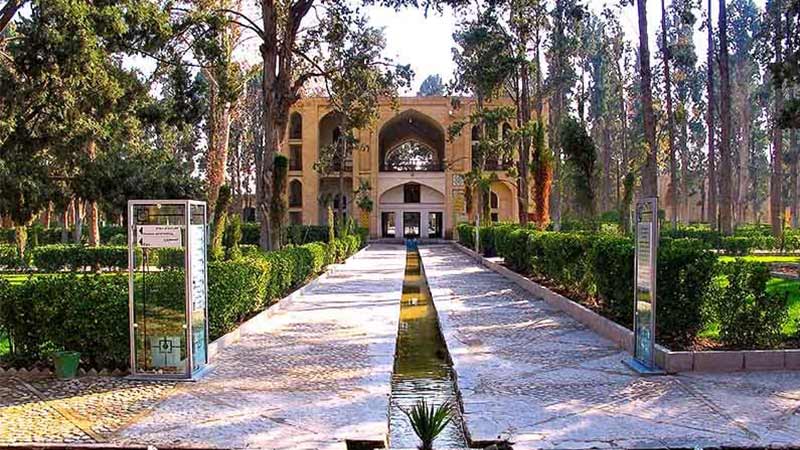
Main Entrance Building
The Main Entrance Building, a two-story structure, is located at the very entrance to Fin Garden. Built during the Safavid era, it has a hall that connects the outside and inside of the garden. On the ground floor, there’s a vestibule where visitors would wait. Following this, there are an entrance hallway and side rooms. The Main Entrance Building, besides a large hall, has verandas that overlook all four sides of the garden.
Royal Room
Mohammad Shah Qajar ordered the construction of a building in Fin Garden known as the Royal Room. This room was also referred to as the “Five-Door Room” and “Arsi Room” due to its five doors (windows) overlooking the courtyard and its vertical sliding shutters. Rooms called “Ear Rooms” existed on both sides of this building for the staff, who used side doors for ceremonial purposes.
The ceremonial room has five doors with lattice windows and rosehead nails, which, apart from being decorative, protected the wood from termites. The colored glass windows are also very eye-catching. One reason for using this type of glass was to repel insects. Channels were installed in the baseboards to prevent moisture from the pool in the middle of the room from damaging the structure, allowing air to flow behind the main wall.
Qajar Pavilion
The Qajar Pavilion was built on the orders of Fath-Ali Shah. It’s also known as Fath-Ali Shah’s Sofeh and Fath-Ali Shah’s Camel’s Neck. The building includes various sections like a four-arched structure with a bubbling pool, a pool house, and a covered terrace with four ivans and a royal seating area. There are two private courtyards on the south and north sides of the pavilion, equipped with several rooms and living amenities.
In the pavilion’s ceiling, you can find paintings by Sani ol Molk Ghaffari, much of which were damaged over time due to neglect, human interference, and moisture. Interestingly, years later, a photo of these beautiful paintings was found in a French tourist’s album, leading to their restoration by Master Matifi-Far. The original parts of the paintings are lighter in color, while the restored sections are more vibrant. The paintings above the pool depict royal feasts, hunting scenes, Quranic stories, and events from the garden itself, including portraits of Fath-Ali Shah’s 18 sons around the pavilion’s ivan.
Women’s Spring (Water Distribution Point)
The teahouse, formerly known as the Women’s Spring, is located beside the Qajar Pavilion. The incoming water to the garden is divided into three streams here, flowing beneath the bubbling pool, Qajar Pavilion pool, and Safavid Pavilion pool (Safavid Camel’s Neck). The water supply for the fountains and canals is managed through this system.
The water distribution technique involves using ceramic pipes that channel water from Suleimaniyah Spring to the Safavid Camel’s Neck. Due to a bend at the end of the pipe, the water flow is slowed down, ensuring a steady and even flow out of the pipe.
Bathhouses of Fin Garden
There are two bathhouses in Fin Garden, known simply as the Fin Bathhouses due to their location. These bathhouses are among the most important and famous structures in the garden, notably associated with the assassination of Amir Kabir.
Royal Bathhouse
The Royal Bathhouse was built in 1189 Solar Hijri on the order of Fath-Ali Shah for the Qajar kings to use during their visits to the garden. A smaller bathhouse was also built for the staff, which was open to the public on certain days of the week. The Royal Bathhouse consists of different sections including a changing room, a hot room, a side corridor for bringing in supplies, and a main courtyard. The main courtyard includes a royal seat, cupping rooms, a water reservoir, hot and cold pools, and a lukewarm pool.
The bathhouse was heated through a furnace and a network of underground channels that transported the heat and smoke to the chimneys. These channels not only expelled smoke but also heated the floor of the bathhouse. The walls were made of Sarooj, a good moisture barrier, protecting the foundation and walls from damage. The bathhouse’s ceiling has openings for light.
Safavid Bathhouse
The Safavid Bathhouse, also known as the Amir Kabir Bathhouse, is where Iran’s prime minister was assassinated on the 20th of Dey, 1230 Solar Hijri. Built around 882 Solar Hijri, it largely resembles the Royal Bathhouse. A notable feature of this bathhouse is its seven tiles in the reservoir, dating back about 500 years.
Karim Khan’s Private Courtyard
Karim Khan’s Private Courtyard, built on the southwestern front of the garden on his order, consists of five-door rooms, simple rooms, and a small courtyard. The courtyard is flanked by interconnected rooms.
Fortress and Walls of the Garden
The robust fortress and walls are a defining feature of Fin Garden, transforming it into a fortified garden. This not only provided security but also lent a regal grandeur, distinguishing it from ordinary gardens. The main garden fence was built with four towers during the Safavid era and underwent changes and demolitions in later periods. However, during the Qajar era, three towers were added to the garden’s perimeter fence.
Suleimaniyah Spring
The Fin or Suleimaniyah Spring is the source of running water in different parts of Fin Garden, such as canals, pools, and basins. It emerges from a rock called ‘Toothed Mountain’ west of Kashan. The spring, believed to be around 7,000 years old, is considered a miracle attributed to Prophet Solomon, although there’s no evidence to support this.
The flow rate of this astonishing spring is consistently around 360 liters per second, independent of annual rainfall. Interestingly, the water temperature remains at 25 degrees Celsius throughout the year, feeling warm in cold seasons and cool in hot ones. The water is incredibly clear, though not suitable for drinking.
National Museum of Kashan
The National Museum of Kashan, located on the northwest side of Fin Garden, was built in 1346 Solar Hijri on the ruins of Nizam al-Mulk’s private quarters. Nizam al-Mulk (Fath-Ali Shah’s son-in-law) used Fin Garden as his residence and office, building his private and harem quarters outside the main garden area, known as Nizam al-Mulk’s private quarters.
Covering an area of over 300 square meters, the museum consists of a single floor with several large and small halls and a basement. It features three sections: ethnography, archaeology, and handicrafts, displaying pre- and post-Islamic pottery, ceramic items, clothing, calligraphy, and more. Artifacts from the Silk Hill excavations and historical items from cities like Shush, Lorestan, Ismail Abad, etc., add to the museum’s archaeological appeal.
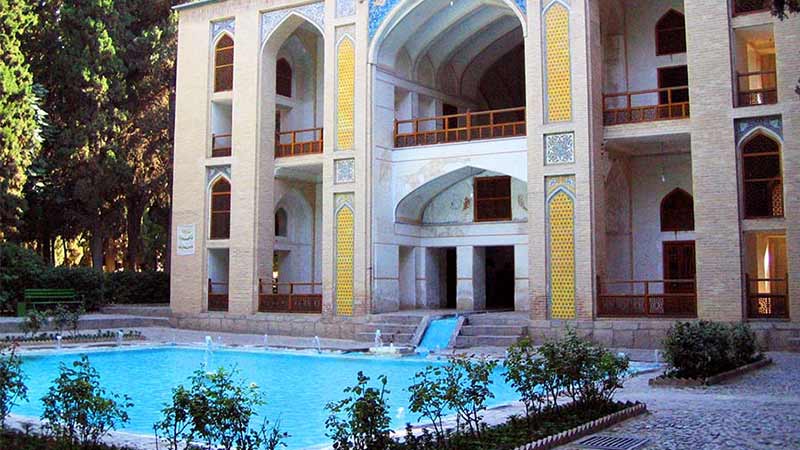
Best Time to Visit Fin Garden in Kashan
Fin Garden, like any other garden, is particularly beautiful in spring and summer. However, visiting in autumn and winter is also delightful.
Conclusion
In conclusion, Fin Garden in Kashan is a breathtaking blend of history, beauty, and culture, offering a glimpse into Iran’s rich heritage. From its historical significance to its serene environment, it’s a place that captivates every visitor. Did you enjoy learning about Fin Garden? If so, we’d love to hear your thoughts! Please feel free to leave a comment and share your own experiences or questions about this stunning garden. Your feedback is valuable to us and to others interested in exploring Iran’s beautiful landmarks.



